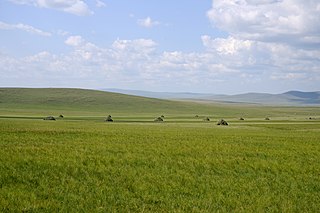
Inner Mongolia, officially the Inner Mongolia Autonomous Region, is an autonomous region of the People's Republic of China. Its border includes two-thirds of the length of China's border with the country of Mongolia. Inner Mongolia also accounts for a small section of China's border with Russia. Its capital is Hohhot; other major cities include Baotou, Chifeng, Tongliao, and Ordos.

Suiyuan was a historical province of China. Suiyuan's capital was Guisui. The abbreviation was 綏. The area Suiyuan covered is approximated today by the prefecture-level cities of Hohhot, Baotou, Wuhai, Ordos, Bayan Nur, and parts of Ulanqab, all today part of Inner Mongolia Autonomous Region. Suiyuan was named after a district in the capital established in the Qing Dynasty.
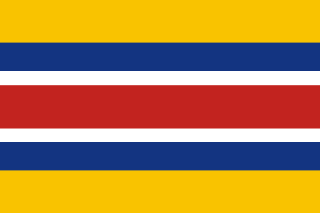
Mengjiang, also known as Mengkiang or the Mongol Border Land, officially referred to as the Mengjiang United Autonomous Government, was an autonomous area in Inner Mongolia, formed in 1939 as a puppet state of the Empire of Japan, then from 1940 being under the nominal sovereignty of the Reorganized National Government of the Republic of China. It consisted of the previously Chinese provinces of Chahar and Suiyuan, corresponding to the central part of modern Inner Mongolia. It has also been called Mongukuo or Mengguguo. The capital was Kalgan, from where it was under the nominal rule of Mongol nobleman Demchugdongrub. The territory returned to Chinese control after the defeat of the Japanese Empire in 1945.

Demchugdongrub, also known as Prince De, courtesy name Xixian, was a Qing dynasty Chinese Mongol prince descended from the Borjigin imperial clan who lived during the 20th century and became the leader of an independence movement in Inner Mongolia. He was most notable for being the chairman of the pro-Japanese Mongol Military Government (1938–39) and later of the puppet state of Mengjiang (1939–45), during the Second Sino-Japanese War. In the modern day, some see Demchugdongrub as a Mongol nationalist promoting Pan-Mongolism, while others view him as a traitor and a pawn of the Japanese during World War II.
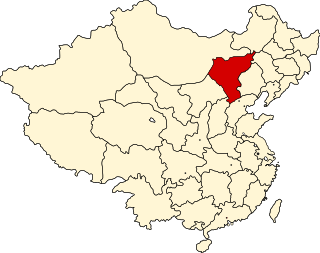
Chahar, also known as Chaha'er, Chakhar or Qahar, was a province of the Republic of China in existence from 1912 to 1936, mostly covering territory in what is part of Eastern Inner Mongolia. It was named after the Chahar Mongols.

Hohhot, formerly known as Kweisui or Guisui, is the capital of Inner Mongolia in the north of the People's Republic of China, serving as the region's administrative, economic and cultural center. Its population was 3,446,100 inhabitants as of the 2020 census, of whom 2,944,889 lived in the metropolitan area consisting of 4 urban districts plus the Tümed Left Banner.

The Hebei–Chahar Political Council, or Hebei-Chahar Political Commission, was established at Beijing under Gen. Song Zheyuan, on 18th December 1935.
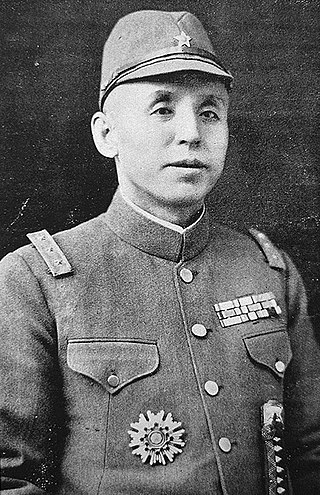
Li Shouxin was a pro-Japanese commander in the Manchukuo Imperial Army and later the Mengjiang National Army.

The flag used by the Mengjiang United Autonomous Government consists of a horizontal colour pattern of yellow, blue, white, red, white, blue and again yellow.
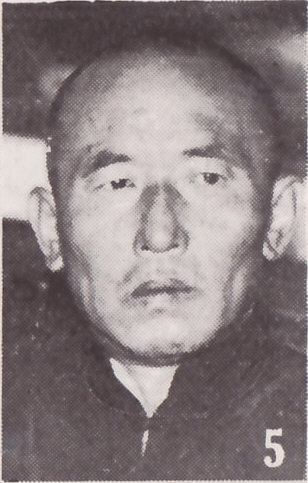
Yu Pinqing was a politician and industrialist in the Republic of China. He was Supreme Member of the Southern Chahar Autonomous Government, later he was also appointed Vice-Chairman of the Mongolian United Autonomous Government and the Mongolian Autonomous Federation. He was born in Nangong, Zhili (Hebei).

Xia Gong was a politician of the Republic of China. He was the Head of the Japanese puppet government known as the North Shanxi Autonomous Government. Later he was appointed Vice-Chairman of the Mengjiang United Autonomous Government. He was born in Datong County, Shanxi province.
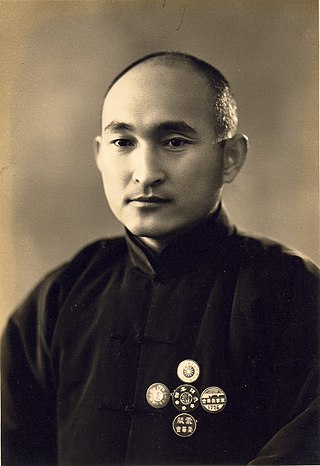
Wu Heling was a politician in the Republic of China. He was born in Harqin Right Banner, Josutu League, Inner Mongolia. His Mongolian name was Ünenbayal. He was ethnic Mongol, and participated in the Mongolian Autonomous Movement. Heling became an important politician in the Mongolian United Autonomous Government and the Mongolian Autonomous Federation (蒙古自治邦).

Jodbajab, also known under the courtesy name of Shih Hai was an Inner Mongolian military officer and government official during the late Qing dynasty and Mengjiang governments. He was an ethnic Mongol belonging to the Plain and Bordered White Banner of Xilin Gol League.
The Mongol Local Autonomy Political Affairs Committee (蒙古地方自治政務委員會), also referred to as the Pailingmiao Council or Peilingmiao Council, was a political body of ethnic Mongols in the Republic of China between 1934 and 1936. The Nationalist government authorised its establishment in March 1934.

Altanochir was an Inner Mongolian jasagh, politician, and general under the Republic of China and Mengjiang governments. He served as deputy head of Yeke-juu League. An ethnic Mongol, he was a native of Right-Wing Rear Banner, Ordos.

The North China Buffer State Strategy is the general term for a series of political manoeuvrings Japan undertook in the five provinces of northern China, Hebei, Chahar, Suiyuan, Shanxi, and Shandong. It was an operation to detach all of northern China from the power of the Nationalist Government and put it under Japanese control or influence.

The Yuan of Mengjiang is the monetary unit that was issued in 1937–1945 by several governments of Mengjiang.

The North Shanxi Autonomous Government was an administratively autonomous component of Mengjiang from its creation in 1937 to its complete merger into Mengjiang in 1939. Following the Japanese invasion of China in July 1937, regional governments were established in Japanese-occupied territories. After Operation Chahar in September 1937, which extended Japanese control to northern Shanxi region, more formal control of the area was established through the creation of the North Shanxi Autonomous Government, as well as the South Chahar Autonomous Government to the east of Shanxi.
Cui Xiaoqian was a government figure in both Mengjiang and North Shanxi during the Second Sino-Japanese War when these regions were under Japanese occupation. Little information is known about Cui himself, though his position inside the North Shanxi Autonomous Government is apparent.
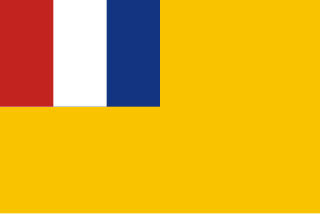
The South Chahar Autonomous Government was a puppet state of the Empire of Japan, as well as an administratively autonomous component of Mengjiang from its creation in 1937 to its complete merger in 1939. Following the Japanese invasion of China in July 1937, regional governments were established in Japanese-occupied territories. After Operation Chahar in September 1937, which extended Japanese control to northern Shanxi region, more formal control of the area was established through the creation of the North Shanxi Autonomous Government, as well as the South Chahar Autonomous Government to the east of Shanxi.

















